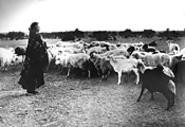Spider Rock, a solitary column of red sandstone, towers 800 feet above the eastern floor of Arizona's Canyon de Chelly. According to Navajo beliefs, the rock's craggy peak was home to Spider Woman, who created the tribe's 12 major gods there. She also taught her people how to weave, and her consort, Spider Man, showed them how to build a loom and tools out of stones.
In truth, the Pueblo Indians taught Navajo women how to weave some 450 years ago. But the myth illustrates the significance of weaving and craftsmanship in Navajo culture. For at least a century, females who knew their way around a loom have been prime wife material -- after all, they're perennial breadwinners. Back in the 19th century, Mexicans paid up to $60 for the women's warm, waterproof blankets; today, collectors shell out $10,000 to $20,000 for a rug.
Diné: "The People": Life and Culture of the Navajo, on view at the Cleveland Museum of Natural History, showcases their world-famous textiles, along with jewelry, paintings, and other artifacts produced between the 1860s and 1960s. This resilient people used their artistry to help rebound from genocide and become the second-largest U.S. Indian tribe today. The Diné ("people") borrowed the crafts, designs, and ideas of other cultures, but always transformed them into something uniquely their own.
The exhibit, drawn from the Harmsen Museum in Colorado and organized by the Colorado Historical Society, provides a cultural and geographical context in which to place the objects. Six adroitly composed black-and-white photos (all undated), blown up to nearly life-size, are posed snapshots of everyday Navajo life: a woman tending her flock of sheep, another weaving on her indoor loom, a man making silver jewelry. There's a map of the 25,000-square-mile Navajo Nation, which currently spans Arizona, New Mexico, Colorado, and Utah. "Chimney Rock," a 1966 oil painting by Juan Nakai, offers a glimpse of Dinehtah's (Navajoland's) mesmerizing beauty.
But the Navajo rugs and blankets are unquestionably the stars of the show. Their vibrant colors and bold geometric designs have a universal aesthetic appeal. But unlike the contemporary textiles for sale in chichi Santa Fe shops, these were created by anonymous weavers who produced them as trade goods, for sale at trading posts or through catalogs. It wasn't until the late 1960s, when roving New York gallery owners "discovered" Navajo textiles, that the rugs turned into "art" and their makers into "artists."
The Western notion of art as an object, to be enjoyed as an isolated aesthetic experience, was once an alien concept in the traditional Navajo worldview. "Art" was part of everyday life: It kept them warm (blankets), held their food and water (pottery), declared their wealth (silver jewelry), and cured the sick (sand paintings). The bonus: It was also beautiful.
Everything changed in the 1860s. When the Navajo protected their homeland from white settlement, the U.S. Army torched their crops and livestock. Then the starving Navajo were forced on the "Long Walk," a 300-mile hike to Bosque Redondo in New Mexico, where they spent three years in captivity. The U.S. government gave them a reservation in 1868, after deciding it had spent too much on the relocation experiment.
Complete cultural upheaval, ironically, pushed the development of Navajo weaving into overdrive. With few jobs on the reservation, selling or trading textiles and jewelry became one of the few ways to earn a living. So the clever Diné learned to produce what Anglo culture wanted.
Today, at viewing areas along the rim of Canyon de Chelly (pronounced "deh-shay"), Navajo artists sell work on the hoods of cars or blankets on the grass. Tourists like to take home a piece of "exotic" culture, so artists mass-produce paintings of mysterious symbols or holy people. Interested in Spider Woman? The guy who paints copies of ancient petroglyphs on rock shards will whip up a picture of her, and a story, too. Chances are he's humoring you. It's a way of survival he learned from his elders.
Most of the exhibit's textiles were made post-Bosque Redondo. By the 1880s, consumers wanted floor rugs and decorative pieces, not blankets. So, Anglo owners of trading posts encouraged weavers to develop new color schemes that would appeal to tourists and home decorators alike. New weaving styles resulted, each named after the region where it developed: Ganado, Two Gray Hills, Teec Nos Pos, Klagetoh, and Crystal. The show has exceptional examples of these rugs and an easy-to-read chart that explains each regional style.
Creativity thrived. In fact, some experiments with form predate those of modern art by 50 to 100 years. An " Eye Dazzler" (1885) uses color and line to create the illusion of movement, predating 1960s op art. With its squares of strategically placed yellow, orange, and red, "Two-Faced Rug" (1885) presages Mondrian's gridlike canvases. Weavers also created pictorial rugs that depicted everyday scenes, Yeis (supernatural holy people), or Yeibechais (dancers dressed as Yeis). The rugs sold well, and the new genres allowed weavers to expand their design vocabulary.
There's just one cheesy element to an otherwise outstanding show: the Native American new-age music piped through the room's speakers, complete with the "bum bum bum bum" drumbeat popularized in John Wayne westerns. The soundtrack seems to contradict what the show celebrates: the survival of a unique Navajo culture, distinct from other Native American tribes. The Navajo are famous for their healing chants and songs. Why don't we hear those?


